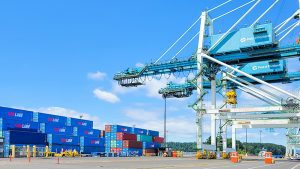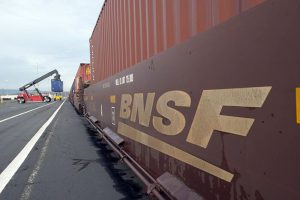
A year-and-a-half after weekly container service returned to the Port of Portland’s Terminal 6—thanks to South Korea-based carrier SM Line—more container service is arriving to help address supply chain issues for local businesses, farmers and consumers.
The new business at Terminal 6 includes:
- An SM Line expansion that will add two additional vessels per month;
- An additional weekly container service operated by MSC, the second-largest carrier in the world, and;
- New private charter vessels and domestic 53-foot containers.
“Terminal 6 is productive and busy at a time of economic recovery that is so important to our regional economy,” Port of Portland Chief Operating Officer Dan Pippenger said. “That wouldn’t have been possible without SM Line committing to the Portland market and the hard work of all the workers on site.”
“In the last year, longshore workers endured a pandemic, an unprecedented wildfire season and snowstorms—and through it all, they kept goods and products moving in and out of the region,” he added. “While these new services won’t solve supply chain issues overnight, they will help local businesses find alternative shipping options in our region.”
The additional container service is also expected to bring better-paying maritime, warehouse and trucking jobs to the region.
”ILWU Local 8’s membership is excited about the progress that the port has been making in marketing its facilities and infrastructure,” Local 8 President Mike Stanton said. “The Local fully supports the port’s mission to partner with Industry to create jobs and community prosperity for the greater State of Oregon and the Columbia River Region.”
In 2020, the Pacific Northwest’s connection to the global supply chain was more evident than ever. From toilet paper shortages to months-long delays for appliances, both consumers and businesses struggled to get the daily supplies they needed. These impacts still continue to be felt.

While varied, the most common goods arriving to Oregon in containers include auto parts, furniture, bedding and lighting, and footwear and apparel. The most common items leaving Terminal 6 are hay and animal feed, agricultural commodities and wood and paper products.
SM Line Partnership
In 2020, SM Line brought weekly container service back to Portland for the first time in more than four years. The port has said that despite global supply chain disruptions, the service was consistent and productive in 2020. The result was the port’s highest container traffic total since 2014, according to data.
Due to the success of the partnership, SM Line is expanding its Portland operations. In addition to continuing its weekly container vessel call, SM Line is beginning a new intermodal rail service via the Union Pacific railway to Chicago in 2021. The carrier will also bring in additional loader vessels every other week to handle local cargo. Including all of these options, SM Line is expected to load at least six vessels every month.
“We (give) thanks to the leadership of (the) Port of Portland and Governor Kate Brown (for) their willingness to bring weekly container service back to Portland,” SM Line Managing Director Kwang Kuk Choi said. “And also very special thanks to longshore workers for their hard work to keep our PNS (Pacific North-West Service) fluid during an unprecedented period of pandemic and supply chain disruption.”
“But we do not stop here,” he continued. “We are pleased to contribute to the resolution of the supply chain constraints in the West Coast of the United States through Portland.”
“Portland is an important strategic port for our company, constantly pioneering new markets,” he remarked. “SM Line will develop and provide competitive logistics solutions that cover both the sea and inland through partnership with the Port of Portland.”
MSC to Portland
MSC’s Santana route—launched in 2020—began calling Portland with a weekly Transpacific service in mid-September. MSC has the largest container fleet to ever come to Portland and marks only the second time in nearly 15 years that the port has secured a second weekly Transpacific partner.
Two other things make the Santana route compelling for local shippers, according to the port. One is that it’s an express service with only four port calls: Yantian – Shanghai – Portland – Tacoma – Yantian. Second, Portland is also the first port-of-call on the route. Most Transpacific services stop at two or three ports in North America before Portland, with most of the cargo getting unloaded on that first port call. Regional importers will now have the fastest transit times from Asia on the market, the port says.
Chartered Vessels
With many ports and inland container yards continuing to experience record congestion, large shippers have opted to use charter vessels to get their goods in a timely fashion. Three shippers are bringing their products to Terminal 6 on chartered vessels. Vessels began arriving in mid-August and will continue to discharge 600 containers every three weeks. These are one-off vessel calls and not part of a regular service.
Similarly, eight vessels containing 53-foot domestic containers—rather than the standard 20-foot size—are calling at Terminal 6. The calls began in August and are planned to run through 2022. Each vessel is expected to have 200-300 containers for unloading.
BNSF Intermodal
In June, BNSF Railway signed a one-year contract to handle intermodal containers between Seattle, Tacoma and Terminal 6. This, according to the port, continues to be a time-saving alternative for some shippers who face delays from truck congestion at ports to the north.
BNSF has handled containers through Terminal 6 since January 2018.

